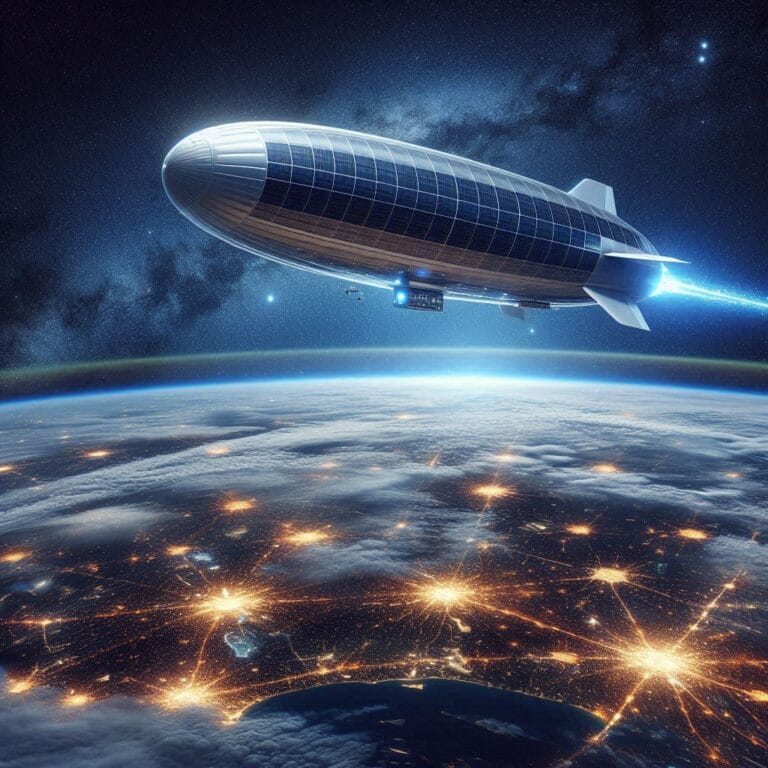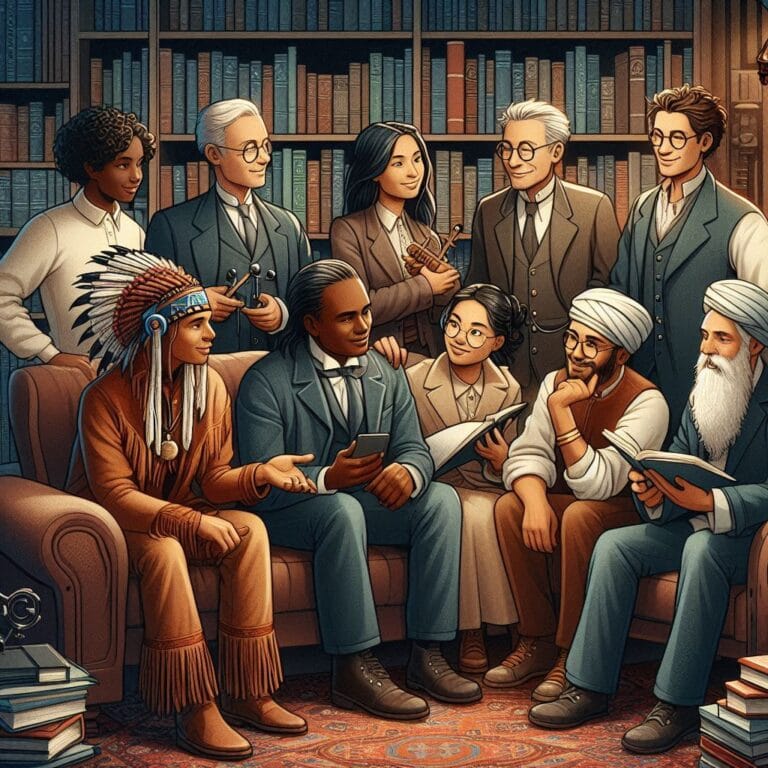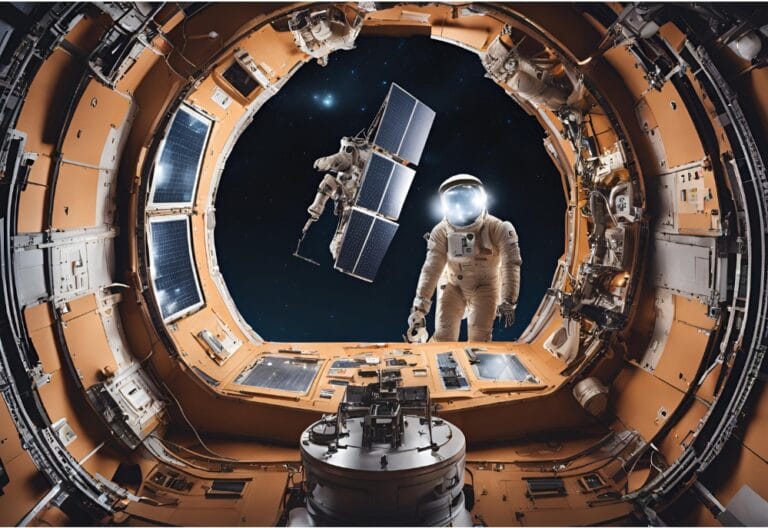🌍 Introduction: Why the World Is Getting Hotter
In 2023, the planet recorded its hottest year ever.
Wildfires raged across Canada and Greece. Oceans reached record-high temperatures. In just one summer, Alpine glaciers shed a staggering 10% of their total ice mass.
These aren’t isolated events—they’re part of a growing trend that scientists around the world are urgently tracking: rising global temperatures. But why is Earth getting hotter, and what role does the air around us—the atmosphere—play in this transformation?
The explanation stems from a delicate interaction between sunlight, Earth’s surface, and certain atmospheric gases collectively called greenhouse gases. These gases, while naturally occurring, are now being intensified by human activity, creating an imbalance in the planet’s heat regulation system.
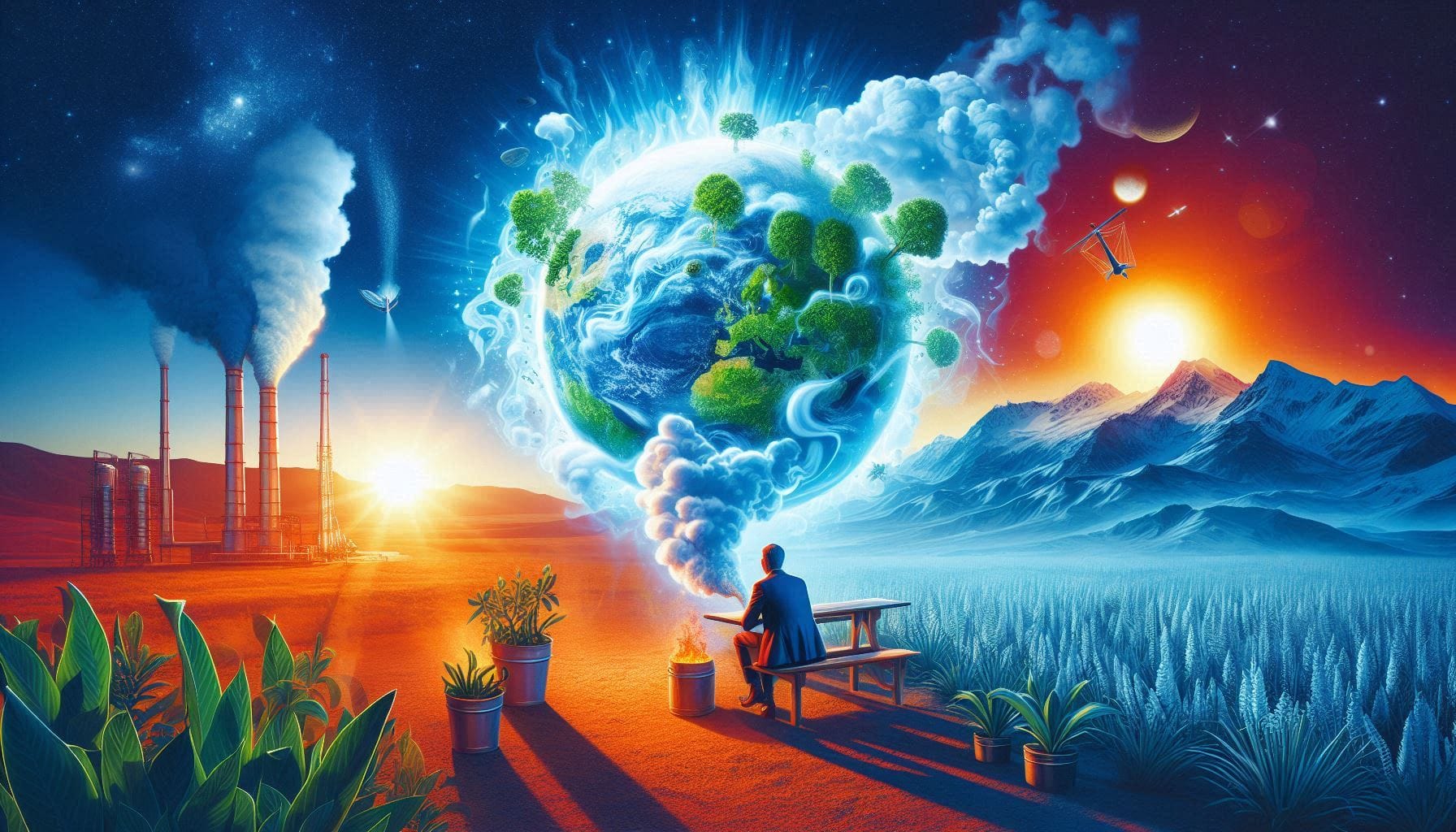
This phenomenon is called the greenhouse effect, and it is the primary mechanism behind how Earth is warming up. As we burn fossil fuels, clear forests, and expand industrial processes, we pump more of these gases into the atmosphere—trapping extra heat and triggering extreme climate changes across the globe.
🔍 In This Blog, You’ll Learn:
- A clear explanation of the greenhouse effect and the science behind how it functions
- An overview of the key greenhouse gases driving global temperature rise
- Insight into how human actions have amplified this naturally occurring process
- The impacts of a warmer planet—from melting ice caps to rising sea levels
- And what we can do to slow Earth’s warming trend before it’s too late
Understanding the science of how Earth is warming up is no longer just for academics or policymakers. It’s crucial knowledge for every citizen of the planet—because our atmosphere is changing, and it affects all of us.
🧪 What Is the Greenhouse Effect?
Picture stepping into a parked car on a scorching summer afternoon—sunlight streams through the windows, but the heat gets sealed inside, turning the cabin into a furnace. Now, scale that effect up to the entire planet. That’s how the greenhouse effect traps heat within Earth’s atmosphere.
So, how do we define the greenhouse effect?
🔍 The Greenhouse Effect Defined:
The greenhouse effect refers to how specific gases in Earth’s atmosphere trap heat, helping to maintain temperatures suitable for life.
🔄 Here’s how the process works:
- Sunlight enters Earth’s atmosphere and reaches the surface.
- The surface absorbs this solar energy and later emits it as infrared (heat) radiation.
- Instead of all the heat escaping into space, a portion is captured by greenhouse gases like carbon dioxide, methane, and water vapor.
- These gases then release the heat in multiple directions, sending some back toward Earth and effectively warming the lower atmosphere.
This natural process is essential—without it, Earth would be a frozen, lifeless planet, with an average temperature around –18°C (0°F). But the problem arises when human activities increase the concentration of these heat-trapping gases, making the planet warmer than it should be.
🌿 Greenhouse Gases That Cause This Effect:
- Carbon dioxide (CO₂) – from burning fossil fuels
- Methane (CH₄) – from agriculture and landfills
- Nitrous oxide (N₂O) – from fertilizers
- Water vapor – amplifies the warming effect
- Fluorinated gases – from industrial processes
🏠 Earth = Greenhouse
Visualize Earth as a giant greenhouse, with greenhouse gases acting like its glass walls—letting sunlight in but trapping heat inside to keep the planet warm.
They let light in but keep heat from escaping—creating a warm, stable environment. That’s perfect for plants… and for humans—until the glass panels get too thick.
🌤️ How the Greenhouse Effect Works (Step by Step)
To truly understand how Earth retains heat, we need to look at the step-by-step mechanics of how the greenhouse effect works. It’s a natural process, but when intensified by human activity, it becomes the main force behind global warming.
Let’s break it down simply.
🔄 Step-by-Step: How Does the Greenhouse Effect Work?
Step 1: Sunlight Enters the Atmosphere
- Solar energy, mostly in the form of visible light, passes through Earth’s atmosphere.
- This light reaches the planet’s surface, warming land, oceans, and everything in between.

Step 2: Earth Radiates the Energy Back as Heat
- Once Earth’s surface absorbs sunlight, it doesn’t hold onto all that energy.
- It releases the absorbed energy back into the atmosphere as infrared heat radiation.
Step 3: Greenhouse Gases Trap the Heat
- Here’s where the key part of the greenhouse effect happens.
- Greenhouse gases such as CO₂, CH₄, and N₂O capture part of the infrared radiation emitted from Earth’s surface.
- Instead of letting the heat escape into space, they re-radiate it back to Earth’s surface and lower atmosphere.
The result? A warming blanket effect that helps Earth retain heat, making the climate livable—but when overdone, dangerously hot.
🌡️ The Delicate Balance
This process has kept Earth’s temperature stable for thousands of years. But as we burn fossil fuels and add more greenhouse gases, the “blanket” gets thicker, trapping too much heat. That’s when a beneficial system becomes a driver of climate change.
💨 The Main Greenhouse Gases and Their Roles
To understand what’s driving Earth’s rising temperatures, we need to look at the top greenhouse gases—each with different sources, warming effects, and atmospheric lifespans. These gases trap heat in varying degrees, and their collective buildup in the atmosphere is what’s intensifying the greenhouse effect today.
Here’s a breakdown of the major greenhouse gases—their sources, effects, and Global Warming Potential (GWP), which indicates how much heat each gas traps over a 100-year period relative to carbon dioxide.
🧪 Top Greenhouse Gases List (with GWP & Sources)
| Greenhouse Gas | Chemical Symbol | Main Sources | Global Warming Potential (GWP) | Role in Warming |
|---|---|---|---|---|
| Carbon Dioxide | CO₂ | Fossil fuels (coal, oil, gas), deforestation | 1 (baseline) | Most abundant; long-lived |
| Methane | CH₄ | Livestock, landfills, oil & gas extraction | 28–36 | Traps heat 25x+ more than CO₂ short-term |
| Nitrous Oxide | N₂O | Fertilizers, soil management, biomass burning | 265–298 | Potent; long-lasting in atmosphere |
| Fluorinated Gases | HFCs, PFCs, SF₆ | Refrigerants, solvents, industrial processes | 1,000–23,500+ | Synthetic; extremely high GWP |
| Water Vapor | H₂O (vapor) | Evaporation, transpiration | Variable (acts as a feedback loop) | Natural; amplifies other gases' effects |
🔍 What Makes Each Gas Significant?
🟩 Carbon Dioxide (CO₂)
- Primary source: Burning fossil fuels and deforestation
- Why it matters: Most prevalent and longest-lasting manmade greenhouse gas
- Impact: Responsible for over 75% of all human-related emissions
🟫 Methane (CH₄)
- Primary source: Agriculture (cow digestion), natural gas leaks, landfills
- Why it matters: Much stronger at trapping heat than CO₂—but with a shorter atmospheric lifetime (~12 years)
- Impact: Major contributor to short-term warming
🟨 Nitrous Oxide (N₂O)
- Primary source: Fertilizers, sewage treatment, fossil fuel combustion
- Why it matters: Affects both global warming and the ozone layer
- Impact: Around 6% of global greenhouse gas emissions
🟥 Fluorinated Gases
- Primary source: Industrial use (coolants, electronics manufacturing)
- Why it matters: Human-made, no natural sinks, can persist for thousands of years
- Impact: Small quantities but very high GWP
🟦 Water Vapor
- Primary source: Evaporation and transpiration
- Why it matters: Not directly caused by humans, but acts as a feedback loop—warmer air holds more vapor, which then traps more heat
- Impact: Amplifies warming caused by other gases
📈 Understanding the names of greenhouse gases, their sources, and effects helps us target solutions more effectively—from clean energy policies to sustainable agriculture.
🧯The Greenhouse Effect of Carbon Dioxide (Why It’s a Big Deal)
When it comes to global warming, no greenhouse gas gets more attention—or deserves it more—than carbon dioxide (CO₂). If you’ve ever wondered how carbon dioxide causes warming, the answer lies in its abundance, longevity, and central role in intensifying the greenhouse effect.
🌡️ Why CO₂ Is the Biggest Climate Threat
Carbon dioxide is:
- The dominant greenhouse gas released through human activity
- Highly persistent, staying in the atmosphere for centuries
- Accounts for more than 75% of emissions linked to fossil fuel use globally
Even though its global warming potential is lower than methane or nitrous oxide, its sheer volume and persistence make it the main driver of long-term climate change.
🧬 Primary Source: Burning fossil fuels (coal, oil, natural gas), cement production, and deforestation
📈 The CO₂ Rise Over Time: From Balance to Breakdown
One of the clearest illustrations of how carbon dioxide causes warming is the Keeling Curve—a long-term measurement of atmospheric CO₂ from Mauna Loa Observatory in Hawaii.
🔍 Key Milestones:
- Pre-industrial CO₂ levels (before 1750): ~280 ppm (parts per million)
- Current levels (2024): ~422+ ppm
- Pace of growth: Climbing more rapidly today than at any time in the last 800,000 years
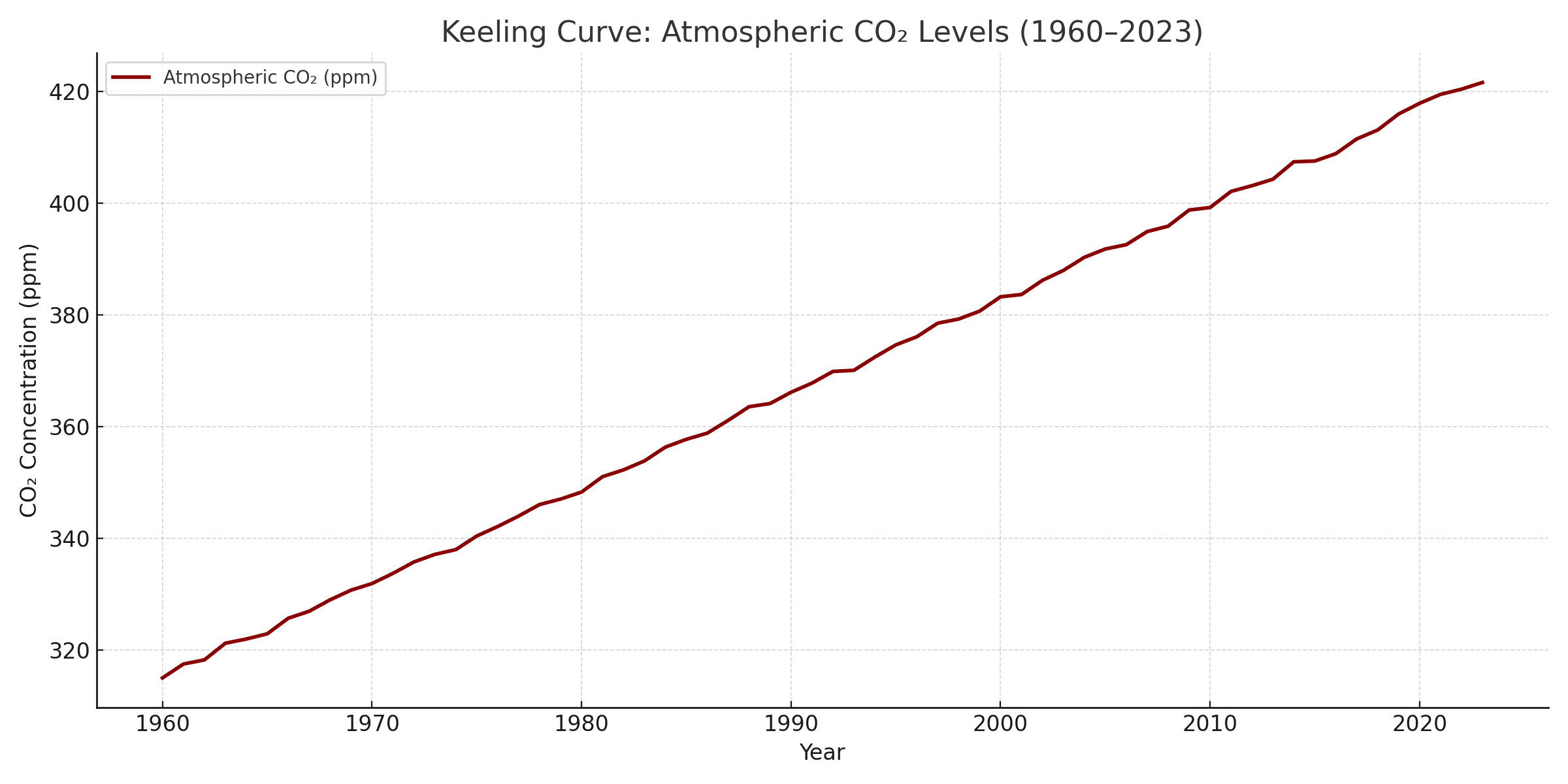
♻️ Feedback Loops: CO₂ and the Warming Cycle
One reason CO₂ is bad for the climate is that it creates self-reinforcing feedback loops that accelerate global warming:
🔁 Examples:
Warming releases more CO₂
-
- As temperatures rise, carbon stored in soils and oceans is released back into the atmosphere
- Melting permafrost releases trapped methane and CO₂
CO₂ warms the planet → more water vapor
- Warmer air holds more moisture
- Water vapor is also a greenhouse gas, which further amplifies heat
These loops mean that even small increases in CO₂ can trigger much larger shifts in climate—from sea level rise to more extreme weather.
🌍 The Role of CO₂ in Global Warming
Carbon dioxide acts like a heat-trapping blanket around Earth, thickening as more is emitted.
Its role in global warming is foundational:
- It’s the baseline used to measure all other greenhouse gases
- It sets the pace for long-term temperature trends
- Reducing CO₂ emissions is key to slowing global warming
🔥 So while all greenhouse gases contribute to climate change, carbon dioxide is the one we must focus on first—and fastest.
🏭 How Humans Are Making It Worse
While the greenhouse effect is a natural and necessary phenomenon, it’s the human activities causing greenhouse gases that have turned this helpful process into a dangerous driver of climate change. Over the past century, our modern lifestyle—powered by fossil fuels, industrial farming, and deforestation—has drastically increased the concentration of heat-trapping gases in the atmosphere.
So, where do greenhouse gases come from, and how are we making the problem worse?
🔍 Major Human Sources of Greenhouse Gas Emissions
🚗 1. Transportation (Cars, Planes, Trucks)
- Main emissions: Carbon dioxide (CO₂) produced by burning gasoline and diesel fuels
- Contribution: Around 15% of global emissions
- Personal vehicles, airplanes, shipping, and freight systems all burn fossil fuels, releasing CO₂ directly into the air.
🏭 2. Industry (Factories, Cement, Steel)
- Primary emissions: CO₂, fluorinated gases
- Contribution: ~24% globally
- Manufacturing processes, particularly in steel, cement, and chemical production, release large amounts of greenhouse gases.
⚡ 3. Energy Production (Power Plants)
- Primary emissions: CO₂, methane (CH₄)
- Contribution: Largest sector at ~35%
- Burning coal, oil, and natural gas for electricity and heat remains the biggest single source of manmade emissions.
🌾 4. Agriculture
- Primary emissions: Methane from livestock, nitrous oxide from fertilizers
- Contribution: ~18% globally
- Livestock (especially cows) release methane through digestion, while synthetic fertilizers emit nitrous oxide—a greenhouse gas 300x stronger than CO₂.
🌲 5. Deforestation and Land Use Changes
- Primary emissions: Loss of carbon sinks, CO₂ release from burning trees
- Contribution: ~11–15%
- Forests act as natural carbon absorbers. When we cut them down or burn them, stored carbon is released into the atmosphere, reducing Earth’s ability to regulate CO₂ levels.
📊 Sector-Wise Global Greenhouse Gas Emissions
Use this chart to visualize where the majority of manmade emissions come from:
| Sector | % of Global Emissions |
|---|---|
| Energy (electricity + heat) | 35% |
| Industry | 24% |
| Agriculture & Land Use | 18% |
| Transportation | 15% |
| Buildings (heating/cooling) | 6% |
| Waste & Others | 2% |
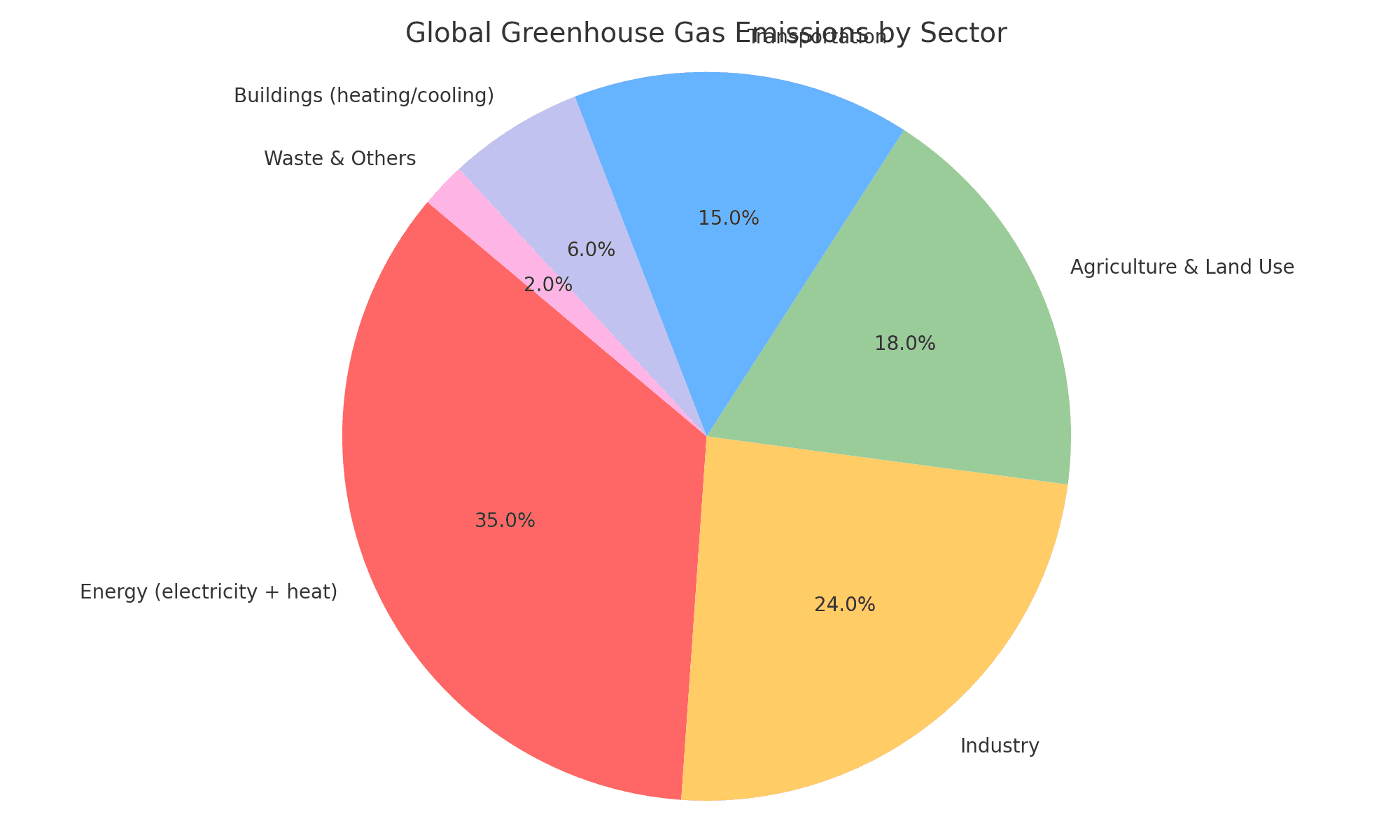
🧩 Connecting the Dots
When we talk about human activities causing greenhouse gases, we’re not just blaming factories or farms. It comes down to how we generate energy, the food we consume, the way we get around, and how we manage our forests. These choices shape the rate at which Earth warms, and by extension, the climate we’ll pass on to future generations.
🌍 Reducing manmade emissions means rethinking energy, transportation, food systems, and land use—all of which are within human control.
🌪️ Effects of the Greenhouse Effect on Earth
The rise in greenhouse gas concentrations isn’t just an atmospheric statistic—it’s reshaping life on Earth. From extreme weather events to shifting ecosystems, the connection between greenhouse gases and weather changes is becoming more visible, more disruptive, and more dangerous.
🌡️ Greenhouse Gases and Weather Changes: What’s Happening?
As carbon dioxide, methane, and other greenhouse gases trap more heat in the atmosphere, the Earth’s climate system becomes unbalanced. This doesn’t just mean warmer days—it means more volatility, as energy moves through the planet in extreme and unpredictable ways.
Here’s how the impact of climate change is unfolding:
🧊 1. Melting Glaciers and Ice Caps
- In the Himalayas, glaciers are retreating at alarming rates, threatening freshwater supplies for over a billion people across India, Nepal, and China.
- The Greenland and Antarctic ice sheets are also melting, contributing directly to rising sea levels.
📉 NASA data shows that global ice mass is declining at nearly 500 billion tons per year.
🔥 2. Increased Heatwaves and Extreme Temperatures
- India has experienced a spike in severe heatwaves, with temperatures regularly exceeding 45°C (113°F) in cities like Delhi and Jaipur.
- These prolonged heat events strain power grids, reduce crop yields, and cause heat-related illnesses and deaths.
🌡️ 2022 and 2023 were among the hottest years ever recorded in India.
💧 3. More Frequent Droughts and Floods
- Higher global temperatures cause greater evaporation, leading to longer and more intense droughts in parts of Africa, Australia, and the western U.S.
- At the same time, heavier rainfall events driven by warmer, moisture-heavy air are causing flash floods in regions like Pakistan, Bangladesh, and parts of Europe.
🌧️ The paradox of climate change: more drought and more flooding.
🌊 4. Rising Sea Levels and Coastal Threats
- As ice melts and oceans warm (expanding in volume), sea levels rise, threatening low-lying countries and coastal megacities.
- Cities like Mumbai, Jakarta, and Miami are already experiencing regular tidal flooding, with some areas projected to be underwater by 2050 if emissions continue unchecked.
🌿 5. Effects on Ecosystems and Biodiversity
- Shifting temperature and rainfall patterns are disrupting ecosystems and species migration.
- Coral reefs are rapidly declining due to rising ocean temperatures and increasing acidification.
- Animals are migrating to higher latitudes or altitudes to survive, disrupting the balance of food chains and habitats.
🐾 Climate change threatens the survival of nearly one out of every six species on Earth.
🔗 All Tied to Greenhouse Gases
These effects are not isolated—they all stem from one root cause: elevated greenhouse gas concentrations. Every ton of carbon dioxide released makes heatwaves hotter, storms stronger, and oceans higher.
🌍 The climate crisis is not a distant threat—it’s unfolding now, in every region of the world.
🌱 How to Reduce the Greenhouse Effect
While the science behind climate change is daunting, the good news is that we already have the tools to reduce greenhouse gases naturally—and they’re within reach for individuals, communities, and nations.
The key to slowing down global warming lies in cutting emissions, restoring natural carbon sinks, and adopting sustainable habits at every level. These solutions aren’t just theoretical—they’re actionable today.
🌎 Global Climate Solutions at Scale
Several international agreements are driving coordinated efforts to reduce emissions and stabilize the climate:
✅ The Paris Agreement (2015)
- 196 countries agreed to limit global temperature rise to well below 2°C, aiming for 1.5°C
- Nations pledged to cut emissions through Nationally Determined Contributions (NDCs)
- Emphasizes a just transition to renewable energy and support for developing nations
Other key frameworks include the EU Green Deal, India’s National Solar Mission, and the U.S. Inflation Reduction Act, all targeting massive reductions in fossil fuel use.
🏡 How to Stop Global Warming at Home
You don’t need to be a policymaker to make an impact. Small actions, when scaled across billions of people, create global change.
🔌 1. Use Renewable Energy
- Switch to solar, wind, or hydro power if available
- Choose energy providers that offer green electricity plans
🚌 2. Use Public Transport or Carpool
- Reduce vehicle emissions by taking buses, trains, bikes, or walking
- Combine trips or use electric vehicles where possible
🌳 3. Plant Trees and Protect Forests
- Trees act as natural carbon sinks, pulling CO₂ out of the atmosphere
- Support reforestation or urban green spaces initiatives in your community
🥦 4. Reduce Meat Consumption
- Livestock farming, especially cattle, emits large amounts of methane (CH₄)
- Incorporate more plant-based meals into your week to help reduce your personal carbon emissions.
♻️ 5. Support Carbon Offset Programs
- These projects reduce or remove CO₂ elsewhere (e.g., tree planting, clean cookstoves)
- Use them to balance your unavoidable emissions (like travel)
🌱 Even simple changes in daily habits can dramatically reduce your personal contribution to global warming.
The future of our planet isn’t decided by one action—but by millions of actions taken daily. Whether you’re planting a tree, riding a bike, or voting for climate policy, you are part of the solution to global warming.
👩🏫 Conclusion: What Students Can Do Today
The science is clear: the greenhouse effect is real, and human activities are accelerating it. We’ve explored how greenhouse gases warm our planet, where they come from, and the devastating effects they have—from melting glaciers to rising sea levels and record heatwaves.
But this crisis isn’t just a problem for scientists or governments to solve—it’s a call to action for everyone, especially the youth.
🎓 Your generation holds the solutions in your hands. You represent the future—and your voice holds incredible power in today’s climate movement.
That’s why student-led climate action has never been more vital. Whether in classrooms, schoolyards, or online, students across the world are already stepping up to lead change—and you can too.
📚 Student Climate Projects and Actions
Here are real, actionable ways students can get involved:
🌿 1. Start or Join a School Eco-Club
- Organize clean-up drives, tree-planting days, or recycling campaigns
- Create awareness posters or climate-themed school events
- Partner with local green NGOs for hands-on work
🧪 2. Do a Climate Science Project
- Measure your school’s carbon footprint
- Build a model to explain the greenhouse effect or solar energy
- Present climate solutions at science fairs or interschool competitions
🚲 3. Promote Green Habits
- Encourage biking, walking, or public transport to school
- Use reusable water bottles, lunch containers, and paper alternatives
- Start a “meatless Mondays” campaign to reduce methane emissions
📢 4. Be a Voice for Change
- Use social media or blogs to raise awareness
- Write letters to local leaders about supporting renewable energy
- Participate in international youth climate movements like Fridays for Future
🌍 Why This Matters to the Next Generation
You will live with the consequences—or the solutions—of today’s climate choices.
Taking climate action as a student doesn’t just help the planet—it builds leadership, creativity, and a sense of responsibility. You are not too young to make a difference, and the world is already listening.
🌍 Interested in tackling climate change beyond just understanding the science?
Check out these powerful solutions and innovations shaping a greener future:
-
♻️ Embrace a Zero Waste Lifestyle – Discover practical steps to reduce your footprint and live more sustainably.
-
🌱 Biocharcoal: A Sustainable Soil Solution – Learn how this carbon-rich material improves soil health while trapping emissions.
-
📡 LIDAR in Environmental Monitoring – See how laser-based mapping is transforming climate research and forest protection.
-
🤖 Swarm Robotics for Environmental Monitoring – Explore how mini-robots are working together to track and protect ecosystems.
-
🧱 10 Sustainable Building Materials – Reimagine construction with eco-friendly materials that reduce emissions from the ground up.
Click through to explore how innovation meets action in the fight against climate change.

